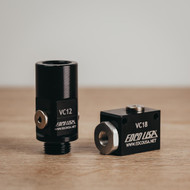Vacuum Check Valves
8th Feb 2021
When vacuum is trapped in a system by a check valve, at least one other valve must be used to vent the system to atmosphere in order to release the work object at the end of the process being performed. For this reason, vacuum check valves cannot be used as stand-alone devices.
Vacuum Check Valves Provide Tight Seals
To be effective, a vacuum check valve must seal bubble-tight and must have a very low cracking pressure so repurposed air check valves are generally unsuitable. For example: 3 psi would be considered a low cracking pressure for an air check, but this translates to 6 inHg vacuum so a pump that develops 25 inHg could only deliver 19 inHg downstream of that repurposed check valve.
EDCO employs either a rubber umbrella seal or a soft-seal guided poppet with a weak spring to minimize cracking pressure but even so, there will be a slight vacuum pressure loss across the valve.
Suitable Applications
To be most effective, one vacuum check should be used with each suction cup for redundancy and isolation of any leaking cups. If multiple cups are served by one check valve, then all cups can lose grip whenever there is leakage of any cup. The most likely cause of cup leakage is a defect or feature of the work object that prevents complete sealing.
Available Options
Vacuum check valves, also known as vacuum one way valves, are available in two different sizes, providing an air-tight, leak-proof design, anodized aluminum body, and optimal flow design. EDCO’s vacuum non return valve options include:
- VC12 - Vacuum Check Valve with G 1/2 NPSF Connections
- VC18 - Vacuum Check Valve with G 1/8 NPSF Connections

